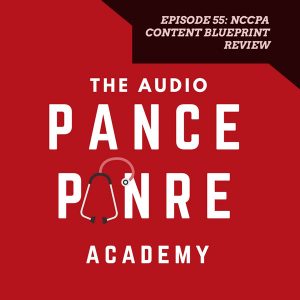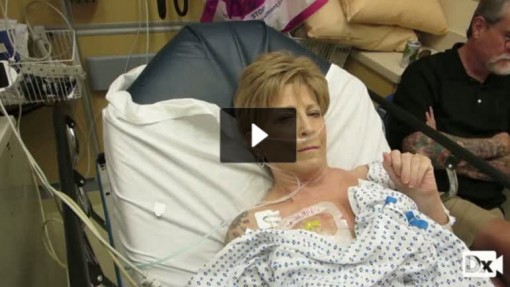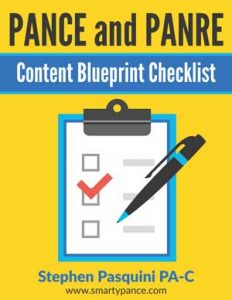Podcast: Play in new window | Download
Subscribe: Apple Podcasts | RSS
 Welcome to episode 55 of the FREE Audio PANCE and PANRE Physician Assistant Board Review Podcast.
Welcome to episode 55 of the FREE Audio PANCE and PANRE Physician Assistant Board Review Podcast.
Join me as I cover ten PANCE and PANRE Board review questions from the SMARTYPANCE course content following the NCCPA™ content blueprint (download the FREE cheat sheet).
This week we will be covering ten general board review questions based on the NCCPA PANCE and PANRE Content Blueprint.
Below you will find an interactive exam to complement the podcast.
I hope you enjoy this free audio component to the examination portion of this site. The full board review includes over 2,000 interactive board review questions and is available to all members of the PANCE and PANRE Academy and SMARTYPANCE which are now bundled together into one very low price.
- You can download and listen to past FREE episodes here, on iTunes, on Google Play Music or Stitcher Radio.
- You can listen to the latest episode, take an interactive quiz and download your results below.
Listen Carefully Then Take The Quiz
If you can’t see the audio player click here to listen to the full episode.
Episode 55 PANCE and PANRE Podcast Quiz
The following 10 questions are linked to NCCPA Content Blueprint lessons from the SMARTYPANCE and PANRE Board review website. If you are a member you will be able to log in and view this interactive video content.
1. Which of the following physical examination findings would be consistent with a pleural effusion?
A. Hyperresonance to percussion
B. Increased tactile fremitus
C. Unilateral lag on chest expansion
D. Egophony
Pleural effusions are covered as part of the NCCPA Content Blueprint Pulmonology section which accounts for 10% of the exam
View this ReelDx patient video case of a 68-year-old female complaining of bilateral chest pain and difficulty breathing. Included in this lesson is the Picmonic explaning Light’s Criteria.
2. A 55 year-old female presents with complaints of stiffness, aching, and pain in the muscles of her neck, shoulders, lower back, hips, and thighs. There is no associated weakness associated with the stiffness and achiness. Laboratory evaluation shows an elevated C reactive protein and erythrocyte sedimentation rate. Which of the following medications is used to treat this condition immediately and will also serve to prevent a known complication from this disorder?
A. Glucocorticoids
B. Cyclophosphamide (Cytoxan)
C. Methotrexate (Rheumatrex)
D. Azathioprine (Imuran)
This condition is covered as part of the NCCPA Musculoskeletal Content Blueprint and accounts for 10% of the exam
3. A 35 year-old pregnant patient presents with fever, chills, and left-sided flank pain. On physical examination left-sided CVA tenderness is noted. Urinalysis reveals numerous white blood cells and white blood cell casts. Which of the following is the most appropriate treatment?
A. Oral ciprofloxacin (Cipro)
B. Oral trimethoprim-sulfamethoxazole (Bactrim)
C. IV gentamicin (Garamycin)
D. IV ceftriaxone (Rocephin)
This condition is covered as part of the NCCPA Genitourinary Content Blueprint and accounts for 6% of the exam
4. A 26 year-old female arrives in the emergency department with friends who say she was standing in front of her church, dressed in a white bathrobe, claiming to be the Virgin Mary and handing out $100 bills to all passers-by. Her friends noted that she had been depressed lately, but now seems completely euphoric. She had a similar episode two years ago. Which of the following is the most appropriate treatment?
A. Inpatient olanzapine (Zyprexa) therapy
B. Inpatient electroconvulsive therapy
C. Outpatient paroxetine (Paxil) therapy
D. Outpatient psychotherapy
This condition is covered as part of the NCCPA Psychiatry Content Blueprint and accounts for 6% of the exam
5. A 19 year-old patient was involved in a motor vehicle crash and brought to the emergency department fully immobilized. The patient sustained multiple blunt injuries to the chest and abdomen. During the trauma assessment, there was no blood at the urethral meatus and a Foley catheter was placed. The urine was positive for blood on the dipstick. Which of the following is the most appropriate diagnostic test
A. Retrograde urethrography
B. CT scan of abdomen and pelvis
C. Serum haptoglobin
D. Urine myoglobin
6. A 48 year-old male presents with complaints of heartburn that occurs approximately 45 minutes after eating about three times a week that is relieved by antacids. He claims to have followed advice about elevating the head of the bed, avoiding spicy foods, and losing weight, but continues to have heartburn. Which of the following is the most appropriate next step?
A. Ranitidine (Zantac)
B. Sucralfate (Carafate)
C. Metoclopramide (Reglan)
D. Misoprostol (Cytotec)
GERD (Gastroesophageal reflux disease) is covered as part of the NCCPA GI and Nutrition Content Blueprint and accounts for 10% of the exam
7. Radioactive iodine (I131) is most successful in treating hyperthyroidism that results from
A. Grave’s disease.
B. subacute thyroiditis.
C. Hashimoto’s thyroiditis.
D. papillary thyroid carcinoma.
Watch this ReelDx Video of a 16-year-old with ADHD presents with chest pain and exophthalmos
Diseases of the thyroid gland are covered as part of the NCCPA Endocrinology Content Blueprint and accounts for 6% of the exam
8. An 8 year-old boy is brought to a health care provider complaining of dyspnea and fatigue. On physical examination, a continuous machinery murmur is heard best in the second left intercostal space and is widely transmitted over the precordium. The most likely diagnosis is
A. ventricular septal defect
B. atrial septal defect
C. congenital aortic stenosis
D. patent ductus arteriosus
This disorder is covered as part of the NCCPA Cardiology Content Blueprint and accounts for 9% of the exam
9. A 63 year-old male with history of hypertension and tobacco abuse presents complaining of dyspnea on exertion for two weeks. The patient admits to one episode of chest discomfort while shoveling snow which was relieved after five minutes of rest. Vital signs are BP 130/70, HR 68, RR 14. Heart exam reveals regular rate and rhythm, normal S1 and S2, no murmur, gallop, or rub. Lungs are clear to auscultation bilaterally. There is no edema noted. Which of the following is the most appropriate initial diagnostic study for this patient?
A. Helical CT scan
B. Chest x-ray
C. Nuclear stress test
D. Cardiac catheterization
Angina is covered as part of the NCCPA Cardiology Content Blueprint which accounts for 10% of the exam
10. A 52 year-old male with history of hypertension and hyperlipidemia presents with an acute myocardial infarction. Urgent cardiac catheterization is performed and shows a 90% occlusion of the left anterior descending artery. The other arteries have minimal disease. Ejection fraction is 45%. Which of the following is the treatment of choice in this patient?
A. Coronary artery bypass grafting (CABG)
B. Streptokinase
C. Percutaneous coronary intervention (PCI)
D. Warfarin (Coumadin)
Acute myocardial infarction [Non-ST-segment elevation (NSTEMI)] and [ST-segment elevation myocardial infarction (STEMI)] are covered as part of the NCCPA Cardiology Content Blueprint which represents 16% of your exam
Looking for all the podcast episodes?
This FREE series is limited to every other episode, you can download and enjoy the complete audio series by joining The PANCE and PANRE Exam Academy + SMARTYPANCE
I will be releasing new episodes every few weeks. The Academy is discounted, so sign up now.
Resources and Links From The Show
- My list of recommended PANCE and PANRE review books
- Download the FREE PANCE and PANRE Blueprint Checklist
- Sign up for the FREE daily PANCE and PANRE email series
- Join the Smarty PANCE NCCPA Content Blueprint Website + The PA Life Academy
- View Tetrology of Fallot Picmonic: Use Code “SMARTYPANCE” to get 20% OFF any year-long Picmonic Membership
- USE CODE “PALIFE” TO GET 10% OFF THE RUTGERS PANCE AND PANRE REVIEW COURSE
This Podcast is also available on iTunes and Stitcher Radio for Android
- iTunes: The Audio PANCE AND PANRE Podcast iTunes
- Stitcher Radio: The Audio PANCE and PANRE Podcast Stitcher
Download The Content Blueprint Checklist
Follow this link to download your FREE copy of the Content Blueprint Checklist
Print it up and start crossing out the topics you understand, marking the ones you don’t and making notes of key terms you should remember. The PDF version is interactive and linked directly to the individual lessons on SMARTY PANCE.



